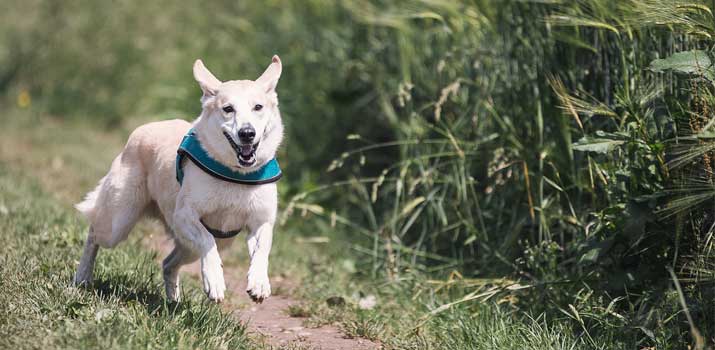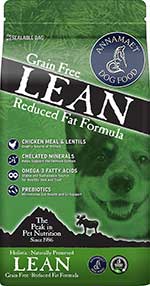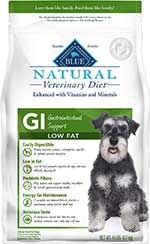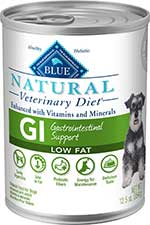Low Fat Diet Dog Food Brand
Believe it or not, fat is an essential nutrient for healthy dogs. It provides energy, fuels the muscles, and makes dry kibble very palatable. But like everything else in the world, too much of a good thing can sometimes lead to a host of problems.
There are many reasons why you might want to switch your dog to a low-fat diet. Excess weight gain is one of the biggest. Dogs have healthy appetites, so it's not hard for dogs to pack on the pounds. This is pretty common as dogs get older and spend less time running around outside.
Unfortunately, losing weight without making some diet modifications is no easy task.

Beyond weight gain, there is also a bevy of health issues that require low-fat diets to manage. Pancreatitis, digestion issues, and more can get worse if your dog is consuming high levels of fat. In those cases, your vet may even prescribe a low-fat dog food to help keep your pup healthy.
Whatever the case may be for your dog, there's no shortage of good low-fat dog food brands out there. These dog foods have lower levels than most commercially available kibbles on the market, making it easy to manage your dog's fat consumption.
5 of the Best Low-Fat Dry Dog Foods Available Without a Prescription
1. Annamaet Grain-Free Lean Low Fat Formula Dry Dog Food (Fat content - 9%)

With only 9 percent fat, this is an excellent choice for dogs that are overweight. Annamet formulated this kibble to provide as much good nutrition as possible. Unlike other low-quality brands, the good stuff isn't sacrificed.
It contains 30 percent protein, which comes from a couple of different good sources. There's also omega fatty acids, DHA, and L-Carnitine to support your dog's entire body.
Mix that in with the collection of fruits and vegetables and you have a balanced diet. This is a grain-free recipe as well, which is great for overall digestibility.
2. Solid Gold Fit & Fabulous Low Fat/Low Calorie Dry Dog Food (Fat content - 6.5%)

Next up, we have the Fit and Fabulous formula from Solid Gold. This dog food has an incredibly low fat content. It's lower than most dog food options on the market.
However, it still has a decent protein content of 26 percent. Most of that protein is coming from fish, which has the added perk of omega fatty acids.
This particular formula is meant to improve various aspects of your pup's health. Not only does it help keep those extra pounds off, but it has probiotics for digestive health, too.
3. Wellness CORE Grain-Free Reduced Fat Dry Dog Food (Fat content - 11%)

This option from Wellness Core has a slightly higher fat content than some other food products on this list. However, that doesn't mean that it won't benefit your dog.
It has roughly 25 percent less fat than Wellness Core's original formulas. Plus, it excels in every other aspect! For example, it has an impressive 33 percent protein. This comes from high-quality sources like turkey and chicken.
Your pup is also getting taurine for better heart health. With no unnecessary fillers or chemical additives to worry about, it's a solid low-fat choice.
4. Earthborn Holistic Weight Control Grain-Free Dry Dog Food (Fat content - 8%)

Meant to keep dogs of all ages fit, the weight control formula does a fantastic job of cutting out the fat while maintaining what's good about the original recipe.
There's only 7 percent fat in total. Yet, there's a decent protein content analysis of 25 percent. The entire formula is grain-free.
Not only that, but it also contains glucosamine and chondroitin. Those are joint supplements that can help alleviate pain. As a result, this is a worthy dog food choice for senior dogs.
Canned Low-Fat Dog Food
5. Purina Pro Plan Focus Adult Weight Management Canned Dog Food

With only 2 percent fat, this Purina Pro Plan formula is good for weight management. Turkey is the primary protein source. However, it also has some liver thrown into the mix to give your pup a boost of vitamins.
The protein is highly digestible. To make sure that your dog has no problem eating it, the food also has prebiotic fiber.
There are a lot of great extras included as well. It's rich in antioxidants, which can help strengthen your dog's immune system. Furthermore, the recipe includes omega fatty acids to support heart and skin health.
4 Commonly Prescribed Low-Fat Dog Food Brands (Prescription Required)
- Hill's Prescription Diet i/d Digestive Care Low Fat Chicken Flavor Dry Dog Food
- Royal Canin Veterinary Diet Gastrointestinal Low Fat Canned Dog Food
3. Blue Buffalo Natural Veterinary Diet GI Gastrointestinal Support Low Fat Dry Dog Food (Fat content - 7.5%)

The low-fat recipe from Blue Buffalo is specifically geared towards dogs with digestive issues. Though, it's a good all-around option if you're looking for a solid low-fat choice.
The thing that sets this food apart is that all of the protein, carbohydrate, and fat ingredients are highly digestible.
This ensures that all the proper nutrients are being absorbed. You'll find things like whitefish, chicken meal, flaxseed, and canola oil. Those ingredients work alongside the prebiotic strains to keep your pup's system in check.
4. Blue Buffalo Natural Veterinary Diet GI Gastrointestinal Support Low Fat Canned Dog Food

Wet canned foods are notorious for having more fat than their dry counterparts. This canned food from Blue Buffalo is the perfect example of a dog food brand doing things right! It's the wet version of the dry gastrointestinal food we went over earlier.
In total, a can of this food only has 1.5 percent fat! Like its dry counterpart, whitefish is the main source of protein. Everything is easy to digest, providing some much-needed relief for your pup. There's also prebiotics and a bevy of healthy extras to balance things off.
What is Considered "Low Fat?"
As we mentioned earlier, fat is an essential nutrient that dogs need to stay healthy. Standard kibbles can achieve their fat content from a wide range of sources. We'll get into that soon.
Typically, your average kibble product is going to have anywhere between 12 and 15 percent fat. Some will go much higher than that and. have an analysis of around 20 percent. Those products are typically geared towards athletic dogs that need as much energy as they can get.
You can check your dog's current food to see where it falls within this range. This should be listed under the "Crude Analysis" section of the ingredient's list.
To be considered a low-fat option, dog foods should have less than the average used in products designed for adult maintenance. So, that means 12 percent or less.
Why Buy a Low-Fat Dog Food?
There are many reasons why your dog could benefit from a low-fat diet. In many cases, owners simply make that choice based on the needs of their canine companion.
Other times, it's recommended and even prescribed by a vet. Here are some common reasons why dog owners decide to make the switch.
Excessive Weight Gain
If your dog is starting to fall out of the healthy weight range for their breed, now is the best time to make the switch. Contrary to popular belief, dogs aren't always the athletic animals we see on television. They are affected by what they each just like humans are!
Poor dietary choices and a lack of exercise could turn an otherwise healthy pup into a magnet for other health issues. Dogs need to burn more calories than they are eating to maintain their weight.
If your pup spends his or her day lounging around the home, it's only a matter of time before you start seeing a significant change in their body condition.
It's just not a cosmetic issue. Overweight dogs are at an increased risk for heart disease, diabetes, high blood pressure, and much more. Thus, it's important to be proactive about your dog's health and make the switch before things get out of hand.
Every dog is capable of gaining weight. However, certain breeds are more susceptible to the problem than others.
These breeds include:
- Beagles
- Bulldogs
- Golden Retrievers
- Labradore Retrievers
- Pugs
- Dachshunds
- Boxers
- Rottweilers
Getting Older
It's not something that too many owners want to acknowledge, but a dog's body changes the older they get. Their metabolism slows down and their joints start aching. It's the perfect recipe for weight gain!
Most senior dogs will start to slow down significantly, putting them at a greater risk for obesity.
You can't expect your dog to stay healthy on the same dog food products they were eating before. Low-fat foods can help to bridge that gap a bit.
Your pup can still enjoy the same amount of food as they did when they were a rambunctious young adult. However, the decreased fat content will help avoid those unwanted gains.
Diabetes
Diabetes is a bigger problem in the canine world than most people think. Several breeds are known to be at a higher risk of the disease than others. That said, every dog can suffer from diabetes.
There is no cure for this ailment. So, it's all about weight and health management. Because your dog's body is processing glucose differently, they will more than likely start to gain weight. When this happens, a diabetic dog can experience several additional symptoms and health issues.
Low-fat dog foods tend to have fewer calories, making them an excellent choice for managing diabetes.
Related: Best Hood for Dogs with Diabetes
Pancreatitis
The pancreas is a small organ that works to produce digestive enzymes. It also plays a role in regulating blood sugar because it produces insulin. Unfortunately, pancreatitis is another incurable disease.
When dogs experience the ailment, their pancreas becomes inflamed. The goal of managing pancreatitis is to minimize the triggering of enzymes that cause inflammation.
It's believed that fat is one of those triggers. As such, veterinarians will usually recommend a low-fat dog food to keep things under control.
This is an instance in which prescribed foods may fair better for your dog than standard low-fat options. Consult with your vet and see what changes they want you to make.
Related: Top 5 Best Dog Foods for Pancreatitis
Digestive Issues
Finally, you might want to make the switch to low-fat dog foods if your pup is experiencing digestive problems regularly. Not every dog is going to handle standard fat levels well.
Some may experience allergic reactions. Alternatively, their system may just not agree with it.
While stomach problems may seem minor, it can be a huge issue if it occurs regularly. Not only is your dog in pain, but the digestive problems prevent all those essential nutrients from getting absorbed into the body.
This usually leads to constant diarrhea and runny stool. Even in the cases when your dog's stool comes out solid, it might be covered in grease! This is a big indicator that their body doesn't handle fat too well.
Switching to a low-fat dog food could alleviate the problem and finally provide your dog with the relief they need.
Also Read: Homemade Dog Food for the Sensitive Stomach:
What Kinds of Fat Should Dogs Eat?
It's not enough to rely on the packaging. You need to do your due diligence and take a look at the nutritional information. Aside from the fat analysis, see what types of fats are used in the food.

Natural animal fat that comes from the primary protein source is best. Those fats are all-natural.
Never go with a food that uses unnecessary extra fat ingredients.
This would include ingredients such as lard. Those fats are heavily processed. Your dog should do just fine with the natural fat from the animal.
Will all that said, you can choose dog foods with ingredients like salmon oil or flaxseed oil. Those are good fats that could actually benefit your dog in the long run. They are chock-full of omega fatty acids, which are essential for your dog's brain function.
They also improve the skin and support many vital biological functions. Those are good fats and should be the only exception to the rule.
Anything Else I Should Look For?
Because the dog food is a bit different than other options on the shelf, you should pay attention to everything it contains.
Protein is essential for dogs . This is even true with obese or ill dogs. You'll see many manufacturers sacrificing on their protein analysis just to reduce the fat. Try to avoid this. Look for products that are packed with healthy protein choices.
Wholesome chicken, beef, fish, and more are all preferred. Avoid those mystery meats and byproducts.
* Consult with your vet for more guidance on what your dog needs. There could be some exceptions based on their health condition.
High Fiber
Another good thing to have is a good source of fiber. High-fiber dog foods improve the digestive system significantly. This has a couple of benefits. For one, it can absolve any diarrhea issues your dog might be experiencing.
Secondly, it makes the food pass through your dog's system quickly and efficiently. The fat that does remain in the dog food won't stick around and cause harm, which is important.
High-fiber foods are typically recommended alongside low-fat foods for dogs with pancreatitis. Again, consult with your vet for more information.
Finally, make sure that the food you choose has all the extras your dog needs. Vitamins, minerals, and complex carbs are a must. Your pup's body is going through some tough times, so you don't want to skimp on the essential nutrients.
Conclusion
Whether you're dealing with weight issues or something a bit more pressing, a low-fat dog food could be the solution you're looking for. Just make sure that you're doing your due diligence.
Don't take a "Low-Fat" label at face value. Your dog's health is on the line! Read up on the ingredients, scrutinize that crude analysis section, and consult with your vet to make sure that it's suitable for your dog.

Source: https://avidpup.com/best-low-fat-dog-food/